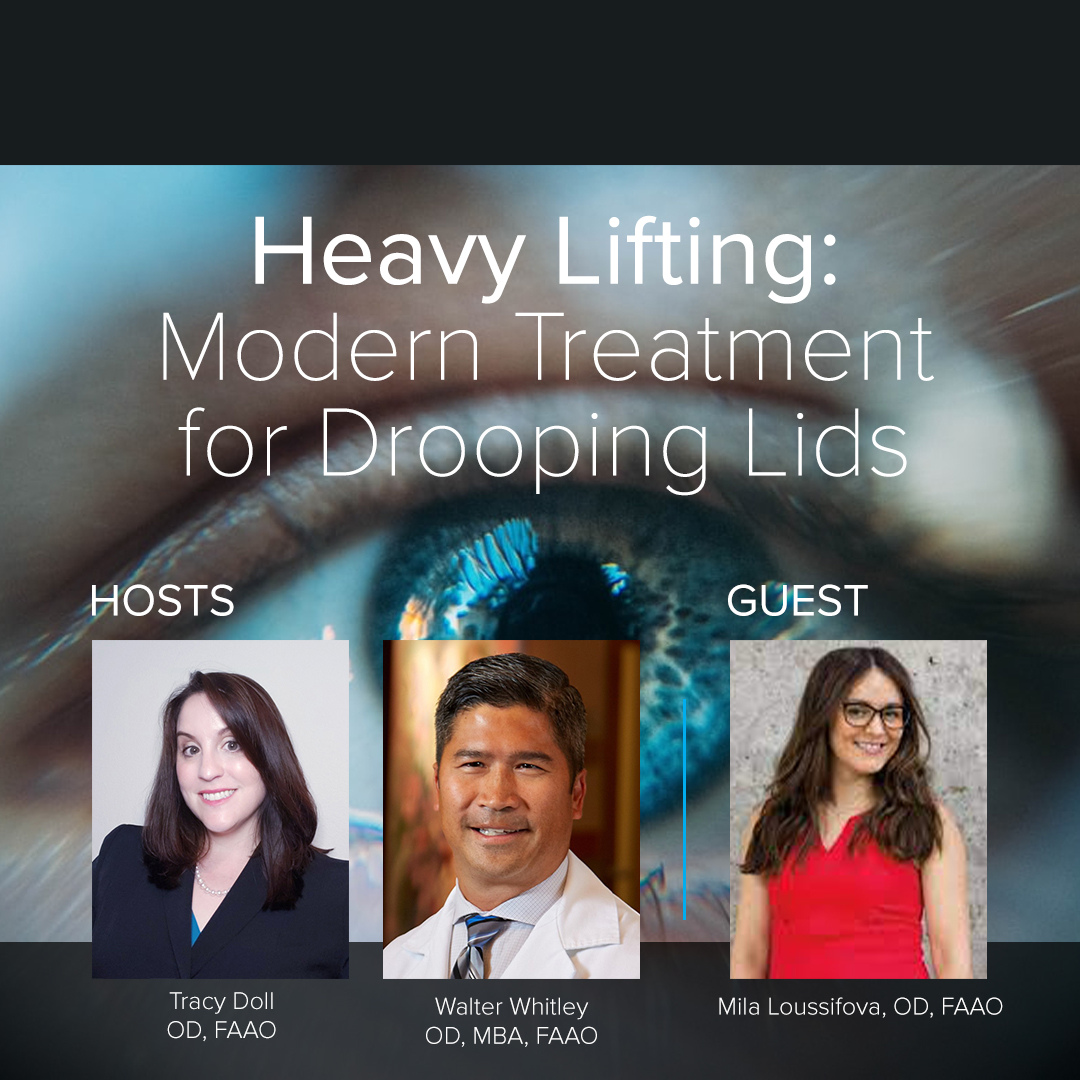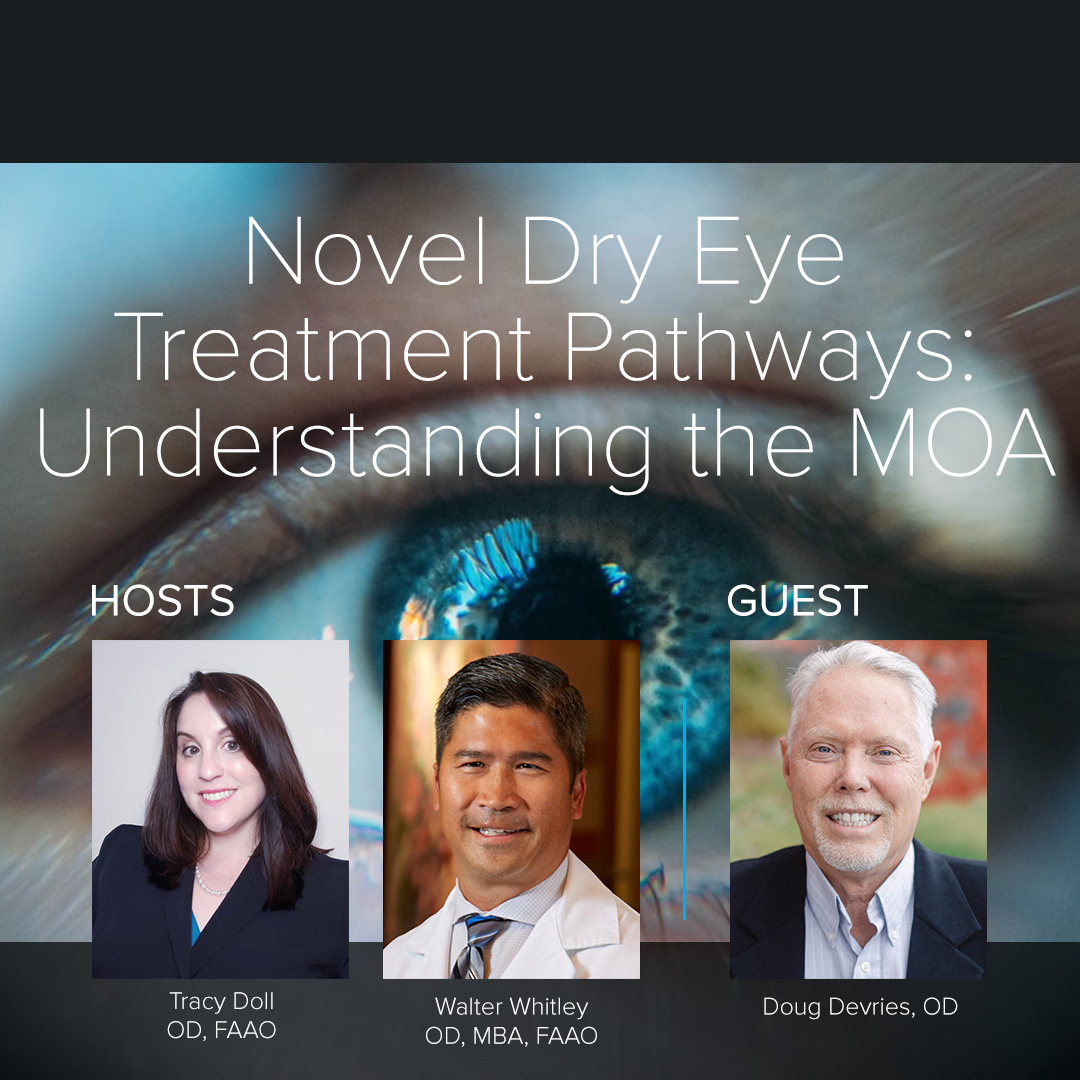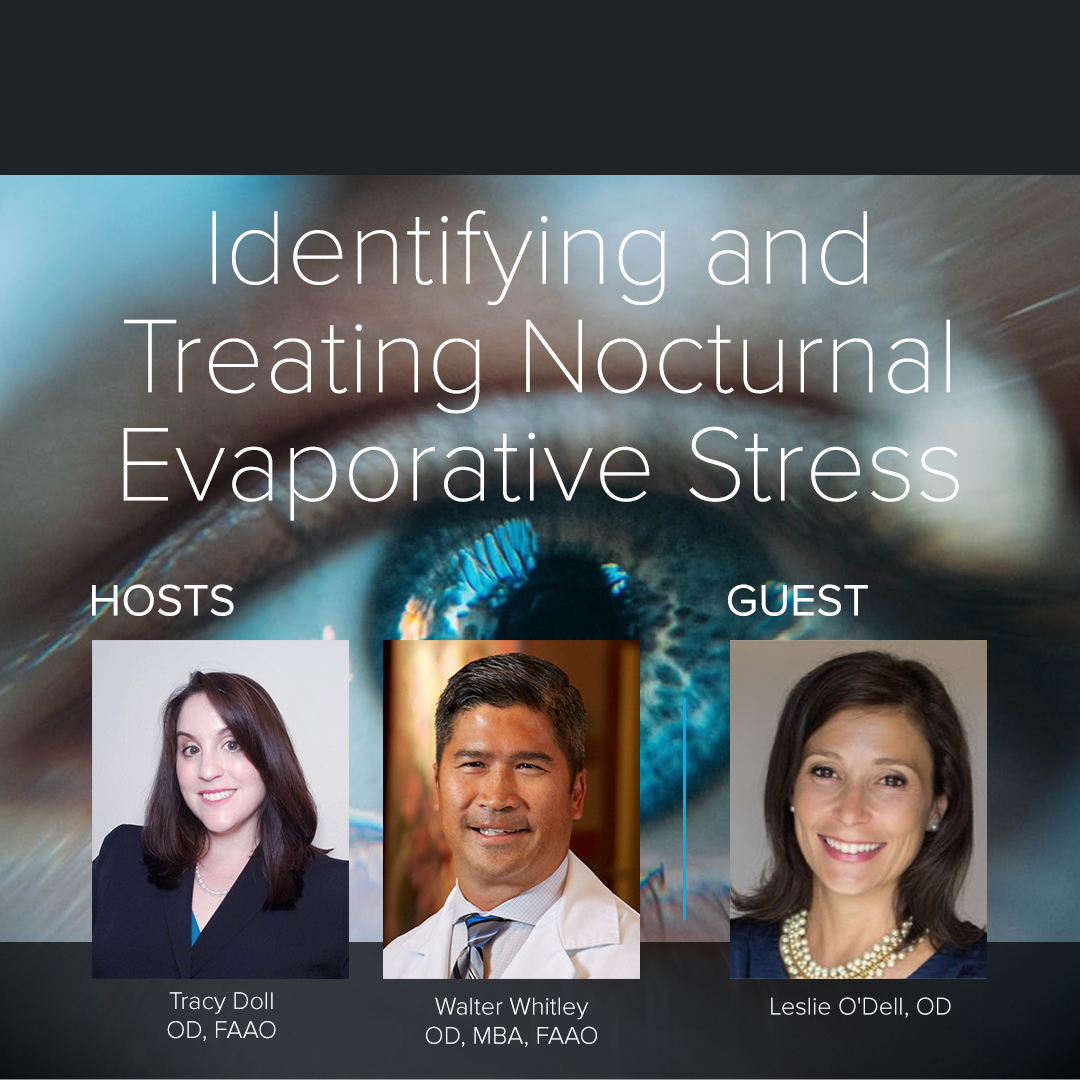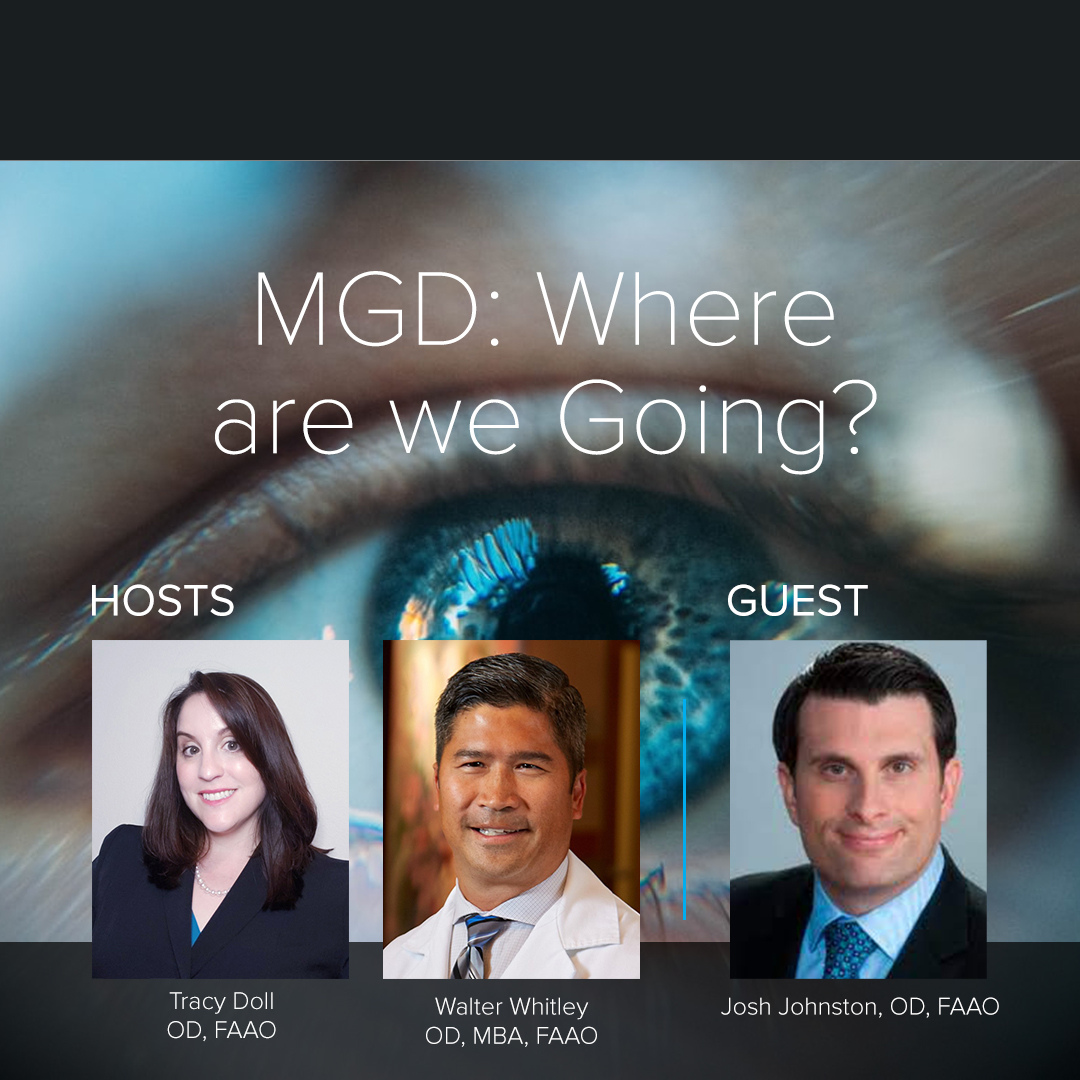Episode Transcript
[00:00:00] Speaker A: Welcome to the Dry Eye podcast series. Click on dry Eye, your insider path to the most exclusive dry eye topics. The series will raise awareness about the current and future state of ocular surface disease. The podcasts will focus on a variety of topics. Before we get to our next episode, here's a quick word from our sponsor. In today's episode, we have the pleasure of speaking with our friend and colleague, Doctor Bila Yusufova, who practices in Portland, Oregon. And we're going to talk to her about modern treatment for drooping lids. Welcome, Mila.
[00:00:33] Speaker B: Thank you so much for having me.
[00:00:36] Speaker A: Now, I know that you and I have Portland pretty well covered because I've got the west side and you're in south Portland, right? Yes. Why don't you tell us about your stunningly beautiful practice? What kind of modality are you in?
[00:00:50] Speaker B: Oh, thank you so much. Kind.
I love having you in Portland with me. So I've been practicing optometry for the. For almost 15 years, and I opened my practice in Portland, Oregon, in south waterfront. So it's called south waterfront eye care.
In 2013, and pretty early in my practice, I decided that I wanted to do more for my patients struggling with dry eye disease. As you, Tracy, and Walt, you can relate. I'm sure it's frustrating to treat patients for dry eye and not get the results. And so over the years, I've invested in all the new tools and technologies to really, and myself, too, to really understand and treat dry eye disease, which is what I love to do. I love treating dry eye. And with that, really, over the time, over the years, I've developed that's kind of dry eyes led me to other interests, specifically like nutrition, to study nutrition and also dabble a little bit in aesthetics.
[00:02:01] Speaker A: So that's an amazing part of your practice. I love it so much.
[00:02:05] Speaker C: Yeah, we love that practice. It sounds like both of our practices. And like I said earlier, it's great to meet you and finally connect with you. And we're so, so excited to have you on this podcast. And so, even though our focus is more on dry eye, we look at these saggy, baggy lids all the time. And so can you talk to us about how addressing ptosis and these baggy lids has impacted your practice? Cause you just mentioned you started to get an aesthetics.
[00:02:32] Speaker B: Yeah. So for me, it's been kind of a natural, like, organic transition or sort of a. You know, we're already in the.
We're looking at eyes and patients coming in specifically for. If it is for dry eye.
It's allowed me to kind of step outside of just, you know, looking, you know, prescribing contacts or glasses and go more with, obviously, with medical practice. But it also allows me to discuss these options that patients may not be aware of. Right. So when patient comes in, they may not necessarily, necessarily think that there are some options that are non surgical. They may not bring it up to you. And when I do talk to them about, like, radio frequency or prescription eye drops, they're happy. They're thrilled, and they want to hear more.
[00:03:23] Speaker A: So you find that patients, you know, it's kind of a tricky thing when you bring up a physical, you know, age related change. Do patients, are they really receptive about talking about their drupal lids?
[00:03:35] Speaker B: Absolutely. I mean, you know, an example, if this happened a couple of weeks ago, had a patient came in, she was 48. You know, she's not.
She's not older patient, but she's saying she's on Zoom all day long and she's tired of, you know, seeing. She specifically said, in the beginning of the day, my eyes look nice and white and open. I mean, now she's also a dry eye patient, but towards the end of the day, maybe her fifth or 6th Zoom call meeting of the day, she's noticing that her eyelids are droopier and she looks more tired.
It's good to be that provider for those patients where I can say, hey, you may not be ready for surgery, and this is a mild case of droopy eyelids. So we're not ready to do surgical consult yet, but there are some options that we can talk about. And she was thrilled. She was, you know, she.
For her, we started on with her with apnea, but there are other treatments that we'll get into in a little bit that work for other patients as well.
[00:04:45] Speaker C: You know, one of the things that we do within our practice, we have that picture that has the different droopy levels. It's with their intake form. So the, by time they come to us, we're like, you know, they're like, okay, well, they need to have this discussion because it's already been brought up just right when they came into the practice. So, you know, so, you know, you identify the patients with the droopy lids, and, you know, we can talk about the drops and we can talk about surgery. And the reason why we're bringing this up is because lid issues do affect the ocular surface and dry eye. And especially patients who've had, you know, botox or if they've had blepharoplasty, that can happen as well. So when you're making that referral, do you differentiate between lid versus brown ptosis, or do you just talk about the droopiness and then defer that to the surgeon?
[00:05:31] Speaker B: You know, when it's severe cases, I tend to defer them. You know, if it's. If it's going to be a surgical case.
Again, example of a case of patient. I had a patient who's 86 came in and she said she was holding her eyelids up while she was reading the news, the morning paper, you know, so in those cases, it's a surgical. And I discuss the surgery and coordinate the referral and follow up with the patient. So as dry eye doctors, obviously, we're also, yes, aware of bad surgery. So really having a good surgeon that you have a good relationship with, and you can see this patient back making sure that they don't have any leg abdominals or corneal exposure after surgery. So cold management is very important. And a lot of times it's the ones that are coming in for more severes. I go straight to consultation surgical with oculoplastic, and I don't really do any of the in office treatments.
[00:06:42] Speaker A: If there's too much skin, there's not a whole lot that we can do in our offices for that. So more milder cases, I know that's what I'm doing for in office things. But if the skin is redundant, if you basically got a second pocket for demodex to breed in, it's time for surgery, right?
[00:07:01] Speaker C: Correct.
[00:07:04] Speaker A: So why don't you tell us a little bit more about these topical treatments? Because I think you mentioned a pneumon, which is oxymetazoline. What is it, and how are your patients accepting this novel medication?
[00:07:18] Speaker B: Yeah, it's, you know, as you know, I got FDA approval last year, and it's been a great, you know, we didn't really have a solution like this or an option for patients. It's an alpha adrenergic agonist, so it works on the Muller muscle, so it causes contraction, which lifts the eyelid temporarily. And it's actually, the half life is pretty good. It's, I think it's from six to 13 hours. So average of 8 hours. So it gives a pretty good duration.
So patients use it in the morning or maybe right before their meetings start, and it covers them pretty much all day. And I love that it's preservative free. So that's a huge thing for us as dry eyed ducks. So that was an important thing for me to look for. I always look for that bak, you know, if medications have Bak, I'm very cautious about them.
[00:08:20] Speaker C: So we have the drops and then, you know, we wanted to get into radio frequency. We know you do a lot of that and that's one of your interests. Can you talk about radio frequency applications in eye care? Whether it's for the droopy lids, you know, its impact on dry eye. And how's it working for you and your practice?
[00:08:37] Speaker B: Oh, I love this treatment. So radiofrequency has been around in aesthetics and dermatology for a long time. And just like intense pulse light, IPL is kind of stepped into the dry eye world.
Radio frequency rf is the new treatment that now we've been implementing. So we've had it for about a year and a half, I believe, in my practice, we've had IPl for longer, for about four years. And they're completely different and we can talk about the differences, but specifically for radio frequency. So what it is, it's radio waves that are generating energy, heat in the tissue, in the skin, and it goes into the deeper. So there are two different kinds. There's monopolar and bipolar. The monopolar, which is what we use, goes into deeper layers of the dermis, where they work on the fibroblast cells. So fibroblasts and that regenerates new collagen and elastin.
When I learned this statistic, I was shocked. Apparently after the age of, like in our mid twenties, you know, it's anywhere from 20 to 25, we started losing about one to 2% of our body collagen in our skin per year. And with that comes wrinkles and saggy skin. And yes, what this does, this treatment actually boosts our own collagen production for us, again, on the skin around our eyes. We're reducing wrinkles and tightening the skin. That helps with lid laxity and also can prevent dermatitulases or chalasis. However, you say it again, that can prevent drupalis down the road. But the way we implement it for dry eye is that it produces, it generates that magic temperature that melts meibum, 42, about 42, but it can go higher. But we use 42 degrees of celsius around the eye. That is enough to melt meibum, so that way we can express glands easier, which is very different from IPL. IPL is a light therapy. It's not radio waves, it's a light that targets vasculature. So for rosacea patients, for eyelid telangiectasia, that's the most appropriate treatment, but they kind of complement each other really well. So once we treat the inflammation on the eyelids with IPL with intense pulse light, then we can add radio frequency to melt the meibum to heat those glands enough for us to be able to breasts the glands. So again, patient comes in, if I'm, if they're dry eye patients, they have MGD.
You know, we have lipoflow in our office, we have meiboflow. So we talk about different options, but when I say, hey, I can treat your dry eye, but I can also smooth out the wrinkles around your eyes and potentially prevent, you know, droopy lids down the road with radio frequency, of course, that's a win win. Patients really are excited about that option.
[00:11:53] Speaker A: It's FDA approved, actually. So radiofrequency does have an FDA approval to treat riot or wrinkles around the eye. So it is an FDA approved therapy for wrinkles. A lot of us, again, are using off label because it does reach that magic temperature. Like you mentioned, Mila, in a perfect world, I would love for every patient to have both of these because they IPl and radio frequency, because they hit two different things and they worked so well hand enhanced.
[00:12:19] Speaker C: Well, since you two know all the answers, and all this because I have no experience with radio frequency. So how many treatments are they doing for radio frequencies? A one time, or is it a four time like IPL? Can you speak to that?
[00:12:32] Speaker B: So, in our clinic, we have, you know, I used to do all these treatments myself in the beginning, but we have, our office is kind of a boutique style, there's only one exam lane. So I found that it was taking a lot of chair time. So now I have two advanced estheticians doing my treatments.
So for skin results, we want multiple treatments. So we want, we recommend, and again, my esthetician might recommend more than I do, depending on the patient's skin and, you know, how much laxity there is. And so that's kind of, I really like that team approach where I recommend it for dry eye, but then I, my esthetician will say, you know what, to get rid of or to lift your eyebrow or eyes a little bit more, we need maybe two extra treatments. So typically about four treatments, but it may be more than that, depending on patient's age, for gland expressions. Again, even one time treatment, essentially, in theory, could warm the glands and you can express them well enough after doing series of IPL treatments case by case. But we typically recommend series of treatments to get the aesthetic results along with the dry eye treatments.
[00:13:48] Speaker C: So you did mention you have several different treatment options. And did I hear you that how you decide between IP and radiofrequency? And, Tracy, please feel free to jump in as well. Is it when they have the rosacea, the telang lactasia? Is that how you're making that decision?
[00:14:04] Speaker B: Yes. Yes.
Radiofrequency generates heat, so if patient has rosacea and a lot of teljiectasia and inflamed and puffy lids, we don't want to add more heat to that, so we don't want to. Those are not good candidates for radio frequency. We do IPL first, calm down the lids, and reduce inflammation. Then we might do a radio frequency if there's too much inflammation. I don't recommend radiofrequency. We might just do a lipoflow on them one time treatment. So it's case by case, and I love having all these tools and technologies, but knowing the right patient or treating the right treatment for the appropriate patient makes it more effective treatment.
Just like not everybody's an IPL candidate, not everybody's a rated frequency candidate. So we really select the treatments accordingly for the patient's condition.
[00:15:01] Speaker C: You know, we're all fortunate to have multiple technologies and procedures to offer our patients. Tracy, I'm just gonna ask you as well on this one. So do you already have that decision made up? Are you not discussing every one of these options with patients because you're gonna be there forever?
[00:15:18] Speaker A: No.
After I do my consult, I have a pretty good idea of what's causing underlying. What's called the underlying dryness. Is it coming from a skin condition? Is it something like rosacea? Or is it something coming from the inside of them, like rheumatoid arthritis? There's a Sjogren's condition. I'm really tailoring the specific indication for the machine to the particular patient. So I tell the patient what I recommend, what I think is the absolute best for them, and then if that somehow is outside of their financial wheelhouse or window, then we scale back. But I'm always tailoring the type of dry eye to the treatment and how their indications go together. So. Rosacea. Absolutely. I feel like we see a lot of rosacea in Portland. Probably you see a lot too, doctor. Right. And it's just. It's rampant everywhere. So I'm pulling out my, you know, my light, my intense pulse light for that one. If it's somebody that's. That's more concerned about aesthetics and a little bit of meibomian gland dysfunction from occupational issues, then that might be where I'm pushing the patient towards radio frequency, say you have to go for why the patient is dry and kind of match it with that. But no, I don't have time, and neither does my dry eye concierge or my helper to go through every single treatment. It's the treatment that fits the patient best. And I tell them what they need.
That's what they want. They don't want to. They don't want to spa menu. They want you to tell them what they need, because the expert, and they've been other places generally before, they've come to see us as leaders in the dry space. They want us to tell them what they need.
[00:16:51] Speaker C: Mila, anything to add on that?
[00:16:53] Speaker B: Yeah, I agree 100%. And, you know, this is why I love dry eye, because, you know, it's challenging, so it challenges me to constantly learn. And, you know, it's multifactorial disease, so we know that there's a lot of factors, so really, it's kind of like putting the pieces of the puzzle together to figure out what's causing their dry eye, because everybody's dry eye is different. And formulating a treatment plan for that specific patient, and that's what works. Well, you know, we're all different.
And that's kind of why I pursued also nutrition, because I found that if we don't address that, if we don't address that, whether it's systemic inflammation and their lifestyle, sleep and their stress levels, there's so many factors in it, and I love that. Again, when we started, seems like even ten years ago, we didn't have as much information on dry eye as we do now. So just ever evolving field.
So that's really exciting, and I love it.
[00:17:57] Speaker C: I just got a million more questions, but my next one is, what are you using to talk to your patients about efficacy?
[00:18:06] Speaker B: Yeah. You know, so I feel like radio frequency right now is where maybe IPL was, you know, 15 years ago, when I think Doctor Toyo started it, like, early two thousands and started doing small studies, you know, and it was probably also anecdotal treatment back then. And now we have, like, it's FDA approved treatment for dry eye. So radiofrequency, you know, we don't have a whole lot of studies. You know, one of the small studies doctor giacoma did where he compared, he did lipid flow in one eye and then radiofrequency treatment and the other in the fellow eye. And it was a small study. I think it was only ten subjects, but the results were that they were equivalent. So the outcome on all metrics were the same between the two treatments. And we do have new studies that are coming out. I think we're going to have more. There's definitely more studies in dermatology for the skin tightening and all that. So we do have good evidence for the skin treatment and for eyes. I think we'll have more down the road in the future.
[00:19:20] Speaker A: I totally agree that the dermatological journals are where we have to start, especially when we're looking at problems stemming from the skin. So I actually started learning a lot more about intense pulse light and radio frequency from reading dermatological journals and searching for those first rather than eye journals. We absolutely do know the temperature at which myba melts. And there's been a different. There's a number of different technologies that are out there for expression. So if you can document and know that you're getting the eyelids to a very specific temperature, we know that mime is going to melt at that temperature. So while we don't have specific studies outside of some of the work that coma has done, we definitely have a body of research that's been done that shows a particular heat combined with expression absolutely does work.
[00:20:08] Speaker B: So maybe we should do a study.
[00:20:10] Speaker A: We should. I know we both have units.
[00:20:15] Speaker B: Yeah, I have more. I think there's going to be more. And again, it's just, it doesn't replace the. What we have, but it definitely complements IPL treatment and we see good clinical results with it.
[00:20:32] Speaker A: Did that answer your question?
[00:20:35] Speaker C: Yes, it did.
[00:20:36] Speaker B: Thank you again. And aesthetics is just a bonus. That's the thing. These patients love that. When I tell them I can treat your dry eye, but also your wrinkles, they're like, yes, sign me up.
[00:20:50] Speaker A: Or with intense pulse light, I'm going to take care of your dry. But by the way, where I'm treating you for your dry is also going to take that severe redness out of your cheeks.
A lot of people are concerned about the out of pocket cost of these things, but what they don't realize is that a lot of patients that are coming to see us have already done cosmetic procedures to try to help their skin. They're just not disclosing it unless we are very particular and ask about it. I know specifically about things like Botox. Nobody tells me unless I specifically point it out, because I know. I know your forehead's supposed to move right there.
[00:21:27] Speaker C: This has been a great discussion there, Mila. Do you have any final pearls? When it comes to the modern treatment of droopy lids or dry eye.
[00:21:37] Speaker B: Yeah. You know, I think this is such an exciting time to be practicing optometry. We have so many cool tools and resources, and we're already kind of in the business of aesthetics a little bit. Right? We sell beautiful frames, and we provide contact lenses and contact. And colored contact lenses for patients. So we are the right providers to talk about that. To talk about aesthetics and non surgical options for droopy lids when it's mild to moderate, when patients may not know that there are some options. So we should just, you know, I encourage my colleagues to just start a discussion and ask patients and talk about the options that we have right now.
[00:22:22] Speaker C: So what you're saying is we all should get into cosmetometry. Is that correct?
[00:22:27] Speaker B: Well, you can just dabble, just like, you know, I'm dabbling a little bit. Why not?
[00:22:32] Speaker C: Well, hey, we love your enthusiasm and your expertise, so thank you so much, Mila, for your time and expertise in helping us address patients with drooping lids and dry eye.
[00:22:43] Speaker B: Thank you for having me.




